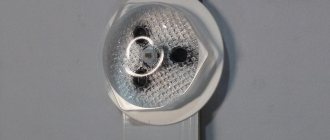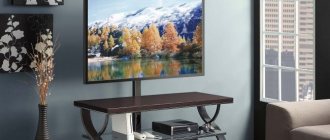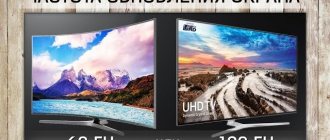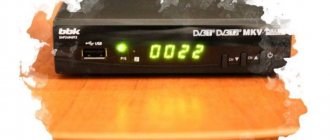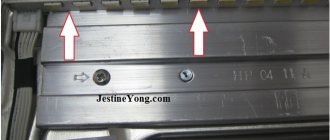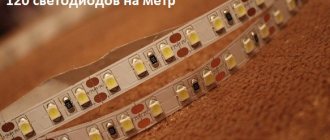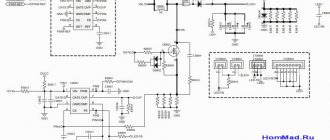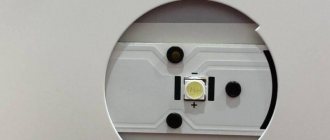Many people do not understand how the Edge LED backlight differs from Direct LED, but this point is important when buying a TV, so you need to understand it separately. The image on the TV or monitor depends on the quality of the backlight and its type. Manufacturers are constantly improving systems, but there are two main options.
The main differences between the two backlight options are in the arrangement of the LEDs.
LED backlighting on TV - what is it and why is it needed?
To understand the purpose of the backlight, you need to understand the screen structure. It consists of three main parts - a protective outer layer, a matrix of pixels and diodes. The protective layer prevents damage to the matrix, which is the main element and transmits the image. But since it does not emit light, in order to see the picture, backlighting is required.
LEDs are much more compact than the fluorescent lamps used previously.
Previously, compact fluorescent lamps were used - an analogue of those installed in lamps. But they were too bulky and did not give the desired effect, so they were replaced by more compact and brighter LEDs. Through their use, manufacturers were able to reduce the thickness and weight of the screen, as well as reduce the energy consumption of equipment.
The quality of the backlight depends on the installed diodes; you should not buy the cheapest models.
Let's determine the malfunction in an ultra-thin TV.
It is not always the burnout of the LEDs that leads to the failure of the TV. It often happens that the power supply or other TV modules fail. Therefore, the first step should be a general diagnosis of the TV.
Our first example will be LG's ultra-thin TV. Let's determine which LEDs are in the TV backlight.
This is an LG model. Very difficult and too expensive. I turned on the TV and turned on the LEDs, but the display was dark. As always, some of the screws on the back and inside of the TV were exposed. As you can see, the power board, logic board, T-con board and finally the LED driver board. My focus was on the LED driver board and LED backlight. It's the one with the metal shield on it.
The first thing to do is make sure that voltage is getting to all the LED modules. Since the standby indicator is on, the logic board is currently healthy. I checked the voltage on the power board and everything seems to be ok.
If you look at the two arrows at the top, you will see the black and red wires. These are the two main power lines to LEDs. There they received a voltage that should be 12 DC on each side. If the board is receiving the correct voltage, but the LED backlight is not lit, this means two things. Either one of the LEDs has burned out, or the board is receiving voltage, but cannot cope with the voltage load, again caused by a malfunction of the LEDs. The only way to find out is to take out the LED strips, check them and determine which LEDs are in the TV backlight.
Advantages and disadvantages of each option
To compare two solutions and understand the pros and cons of each of them, you need to compare the features of each and highlight the positive and negative aspects.
Comparative table of pros and cons.
| Direct LED backlight | Edge LED backlight | |
| Advantages | Uniform illumination of the entire matrix due to the location of light sources and the presence of a diffuser | High brightness and good image contrast. This applies to quality options with bright LEDs and well-tuned reflectors. Screens of this type are bright and well perceived by people's eyes, causing minimal discomfort |
| Good contrast ratio, you can set the perfect image even on a large screen | The thickness of the screen is much smaller due to the lateral location of the backlight, which allows you to make compact models without losing the quality of the equipment and its performance. For example, Slim Direct backlight means that the TV has an ultra-thin screen; many manufacturers name models in a special way, indicating their minimum thickness | |
| Simple system repair due to the convenient location of the backlight unit. Such models are much easier to repair if the LEDs fail | Due to the simplicity of the system, such models are often an order of magnitude cheaper, although it all depends on the manufacturer and the quality of the components | |
| In a dark image, there are no highlights at the edges and corners of the screen. This is a very important factor for those who need the perfect picture. | ||
| When the matrix or housing is deformed, the quality of lighting does not decrease, since the diodes are located at the back and such problems do not greatly affect them | ||
| Flaws | Greater screen thickness due to the additional lighting module and lower brightness levels. | Uneven backlighting in some models; this problem especially often occurs over time when the matrix becomes slightly deformed. Another common problem is glare at the edges of the screen where the diodes are installed. |
Highlights around the edges are usually a problem with side lighting.
Backlighting the LCD matrix with CCFL lamps
CCFL (Cold Cathode Fluorescent Lamps) - cold cathode fluorescent lamps. Previously, HCFL hot cathode tubes were used, but due to their unreliability and short life, they were replaced by CCFL. CCFL lamps are the same fluorescent lamps, only smaller in size. Their operating principle is the same. A layer of phosphor is applied to the inner surface of the lamp, and it itself is filled with a mixture of inert gas and mercury vapor. When voltage is applied, mercury vapor interacts with the phosphor, and it begins to glow.
Illumination of the display matrix with CCFL lamps can be organized in the following ways ⇒
- Lamp placement at the top and bottom of the monitor
- Lamp placement on all four sides of the monitor
- Arrangement of lamps parallel to the entire surface of the monitor
To distribute light evenly by all of the above methods, a special diffusion system adapted to each of them is used, consisting of various shapes and sizes of light guides and prisms. There are quite a lot of options for organizing uniform distribution of light.
This type of backlight is widely used in the production of LCD monitors, televisions and liquid crystal displays for other equipment.
Today, the backlighting of CCFL monitors with lamps has become obsolete and is considered obsolete, but in some areas it is still successfully used.
CCFL backlight technology has greatly lost ground in the production of LCD TVs (more than 90% of all LCD TVs produced today use LEDs as backlight), but in the production of professional and semi-professional monitors for working with images, where color accuracy is very important, it still continues attend. These monitors use high-quality, specially selected lamps that emit uniform and homogeneous light.
LED backlighting using RGB LED can provide the color accuracy of CCFL lamps or even better, but it is still significantly more expensive to implement.
The buyer today has a choice. Save a lot and purchase a monitor using an old type of backlight, but its technical characteristics are practically in no way inferior to modern models, or spend money and choose one of the best professional modern monitors with RGB LED backlighting, which, in terms of the sum of its consumer qualities, will be better than any monitor using as a CCFL lamp backlight.
CCFL lamps with high operating frequencies, which are used in 3D monitors, have also carved out a small niche for themselves. LED backlighting is also used in their production, but its implementation is more complicated and requires more costs.
Which backlight to choose, on what factors it depends
To make a decision, you need to take into account the conditions of use, the location of the TV or monitor, as well as several additional recommendations:
- Options with a thin body are suitable for limited space, as well as for direct wall mounting. This type is used where thickness matters and it is advisable to choose a thinner model.
- If the TV will be placed on a bracket at an angle, it is better to choose products with direct backlighting. The fact is that over time the case may become slightly deformed, which, with side illumination, will lead to disruption of the normal illumination of the matrix.
- When choosing an option with side-mounted diodes, it is worth checking the screen for glare before purchasing. It is best to turn on the blue color, as any problems are most visible on it.
It is better to give preference only to well-known companies with a good reputation.
At the end of the video, it will help you choose the right lighting.
Choosing the type of LED backlight in a TV or monitor is not difficult if you understand the features of each option and take into account the nature of use of the equipment. The main thing is to purchase equipment from well-known manufacturers; this is the only way to guarantee that the declared characteristics will not differ from the actual ones.
What you need to know before buying
Before choosing such a device, make sure that you have everything you need to get a good result.
Firstly, you will definitely have to use some kind of set-top box to display the content. If you use the capabilities of your Smart TV, nothing will come of it. A homemade television set-top box based on Raspberry Pi, a Windows computer converted to a set-top box, and most modern Android TV boxes are suitable.
Secondly, you need a TV with fairly thin frames . If you install the backlight on a panel with a thick frame, a noticeable border will be visible between the picture on the screen and the background lighting and you will not get the full effect of the background glow.
Thirdly, there should be free space for lighting. If the panel is strictly integrated into the interior, installed in a closet or compact furniture, nothing will work. It is advisable that there is nothing around the entire perimeter at a distance of at least 30-40 cm from the TV.
Fourthly, the set-top box used must be powerful enough to handle both playback and image capture for backlighting. Frankly budget models or simple sticks will not work.
Before ordering, you must select the density of diodes on the addressable diode strip (30 per meter or 60 per meter) and its length.
▶ for TVs with a diagonal of 22″ or less, take 1 meter of tape; ▶ for matrices 22″-32″ you will need 2 meters of tape; ▶ for screens 32″-43″ it is recommended to order 3 meters of tape; ▶ for screens 43″-60″, choose 4 meters ; ▶ take a maximum length of 5 meters for screen sizes larger than 60″.
In any case, it is better to measure the perimeter of your TV along the back cover to get the exact size. Also consider whether illumination of the bottom edge will be necessary. When installing the panel on a rack from the diodes from below, you will hardly notice the effect, but if you hang the TV on a bracket, be sure to take into account all four edges.

